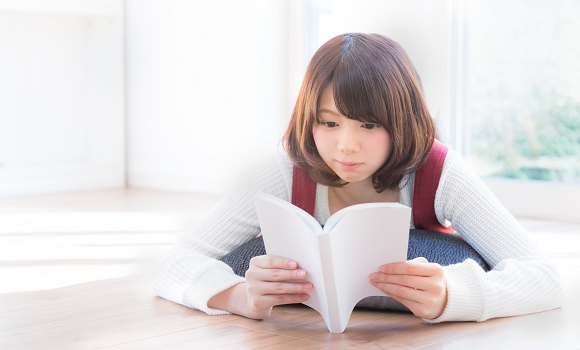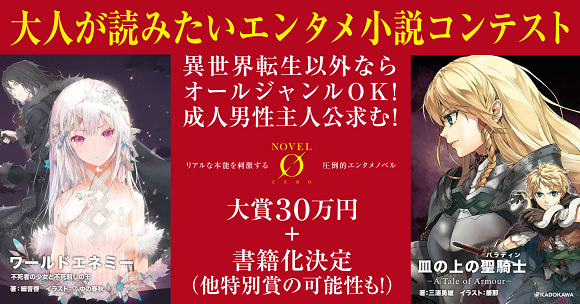
Publisher nixes two of the most common storytelling tricks in the anime playbook in attempt to create something adults can enjoy.
Hey, you know the anime series about the teenage boy? The one who gets transported to an alternate world?
Sure you do. Okay, you may not know the anime like that so much as an anime like that. For that matter, if you’ve been watching Japanese animation for any length of time, odds are you can name several franchises that description works for, since high school kids ending up in isekai, as alternate worlds are called in Japanese, have long been one of the most popular premises in anime.
In recent years, though, the isekai craze has gone into overdrive. It’s gotten to the point where authors of light novels (the serialized paperbacks from which many modern anime are adapted) are having to think of increasingly outlandish scenarios to stand out from the herd, such as making the reincarnated-in-an-alternate-world hero a sentient hot spring that naked women crawl into.
At least some in the industry seem to be of the mind that enough is enough. In the rules for its upcoming light novel contest, publisher Kadokawa has specifically banned both the isekai genre and teen protagonists.
▼ Promotional image for the Entertainment Novels that Adults Want to Read Contest
Back in February, Kadokawa, a publisher of light novels as well as other books, manga, and magazines, formed a new label, called Novel 0, with its theme being “The lifestyle of cool adults.” In keeping with that, Kadokawa’s Entertainment Novels that Adults Want to Read Contest has specified that submissions in any genre are OK, except alternate world stories. Furthermore, the main character must be an adult male, thus ruling out “ordinary high school students” and teenagers in general for the lead (it’s unclear whether older university students would be acceptable leads, as legal adulthood begins in Japan at the age of 20).
Submissions can be made between June 1 and July 16 through the Kadokawa-administered Kakuyomu novel publishing website. Winners will be chosen through a combination of reader rankings and judgement by a panel of Novel 0 editors, with the grand prize being 300,000 yen (US$2,700) and the official publication of the winning novel (full details can be found here).
Taking two of anime’s most representative tropes off the table, even as they remain highly popular among consumers, might seem like a backwards decision given the hugely symbiotic (and profitable) relationship between connected light novels and anime adaptations. Teen protagonists have long been a staple of animation in Japan, since their age makes it easier for young viewers to identify with them and taps into nostalgia among older fans happily thinking back on the good old days of high school.
At the same time, though, the otaku culture boom I gradually causing a change in anime fan demographics in Japan. An increasing number of adults, even those with active social lives, are feeling increasingly comfortable continuing to pursue their anime interests into adulthood. In light of such developments, the rules of Kadokawa’s contest seem like a forward-thinking strategy in trying to develop a new franchise that these adult fans can follow and enjoy in the here and now, instead of having to tap into memories of how they felt a decade or more ago.
Source: Kakuyomu via Yahoo! News Japan/J-Cast News via Jin
Top image: Pakutaso
Insert image: Kakuyomu
Follow Casey on Twitter, where he can’t entirely hate the isekai genre since Escaflowne is technically part of it.


 Bleakly inspiring manga shows what would really happen to average guys in anime alternate world
Bleakly inspiring manga shows what would really happen to average guys in anime alternate world Kyoto Animation arsonist sent more than one novel to company as part of annual writing contest
Kyoto Animation arsonist sent more than one novel to company as part of annual writing contest New survey ranks top ten fan favorites among over 50 Kyoto Animation productions
New survey ranks top ten fan favorites among over 50 Kyoto Animation productions Fantastic fujoshi just wanna have fun, Japanese netizens say, “No!”
Fantastic fujoshi just wanna have fun, Japanese netizens say, “No!” Creepy shrine video has Japanese Internet wondering where it is, if it leads to alternate world
Creepy shrine video has Japanese Internet wondering where it is, if it leads to alternate world Seaside scenery, history, and so many desserts on Yokohama’s Akai Kutsu【Japan Loop Buses】
Seaside scenery, history, and so many desserts on Yokohama’s Akai Kutsu【Japan Loop Buses】 Foreigner’s request for help in Tokyo makes us sad for the state of society
Foreigner’s request for help in Tokyo makes us sad for the state of society Do Hi-Chew-flavor Hi-Chews have a reason to exist?【Taste test】
Do Hi-Chew-flavor Hi-Chews have a reason to exist?【Taste test】 Akihabara pop-up shop sells goods made by Japanese prison inmates
Akihabara pop-up shop sells goods made by Japanese prison inmates Japanese city loses residents’ personal data, which was on paper being transported on a windy day
Japanese city loses residents’ personal data, which was on paper being transported on a windy day McDonald’s new Happy Meals offer up cute and practical Sanrio lifestyle goods
McDonald’s new Happy Meals offer up cute and practical Sanrio lifestyle goods Harajuku Station’s beautiful old wooden building is set to return, with a new complex around it
Harajuku Station’s beautiful old wooden building is set to return, with a new complex around it Japanese ramen restaurants under pressure from new yen banknotes
Japanese ramen restaurants under pressure from new yen banknotes We eat at three Japanese family restaurants to find the one with the best-value breakfast
We eat at three Japanese family restaurants to find the one with the best-value breakfast All-you-can-eat sashimi from Tokyo’s fish market, convenient location make this budget hotel great
All-you-can-eat sashimi from Tokyo’s fish market, convenient location make this budget hotel great French Fries Bread in Tokyo’s Shibuya becomes a hit on social media
French Fries Bread in Tokyo’s Shibuya becomes a hit on social media Studio Ghibli releases new action figures featuring Nausicaä of the Valley of the Wind characters
Studio Ghibli releases new action figures featuring Nausicaä of the Valley of the Wind characters Red light district sushi restaurant in Tokyo shows us just how wrong we were about it
Red light district sushi restaurant in Tokyo shows us just how wrong we were about it New private rooms on Tokaido Shinkansen change the way we travel from Tokyo to Kyoto
New private rooms on Tokaido Shinkansen change the way we travel from Tokyo to Kyoto Tokyo Tsukiji fish market site to be redeveloped with 50,000-seat stadium, hotel, shopping center
Tokyo Tsukiji fish market site to be redeveloped with 50,000-seat stadium, hotel, shopping center Beautiful Ghibli sealing wax kits let you create accessories and elegant letter decorations【Pics】
Beautiful Ghibli sealing wax kits let you create accessories and elegant letter decorations【Pics】 Studio Ghibli releases Kiki’s Delivery Service chocolate cake pouches in Japan
Studio Ghibli releases Kiki’s Delivery Service chocolate cake pouches in Japan New definition of “Japanese whiskey” goes into effect to prevent fakes from fooling overseas buyers
New definition of “Japanese whiskey” goes into effect to prevent fakes from fooling overseas buyers Our Japanese reporter visits Costco in the U.S., finds super American and very Japanese things
Our Japanese reporter visits Costco in the U.S., finds super American and very Japanese things All-you-can-drink Starbucks and amazing views part of Tokyo’s new 170 meter-high sky lounge
All-you-can-drink Starbucks and amazing views part of Tokyo’s new 170 meter-high sky lounge More foreign tourists than ever before in history visited Japan last month
More foreign tourists than ever before in history visited Japan last month New Pokémon cakes let you eat your way through Pikachu and all the Eevee evolutions
New Pokémon cakes let you eat your way through Pikachu and all the Eevee evolutions Disney princesses get official manga makeovers for Manga Princess Cafe opening in Tokyo
Disney princesses get official manga makeovers for Manga Princess Cafe opening in Tokyo Sales of Japan’s most convenient train ticket/shopping payment cards suspended indefinitely
Sales of Japan’s most convenient train ticket/shopping payment cards suspended indefinitely Sold-out Studio Ghibli desktop humidifiers are back so Totoro can help you through the dry season
Sold-out Studio Ghibli desktop humidifiers are back so Totoro can help you through the dry season Japanese government to make first change to romanization spelling rules since the 1950s
Japanese government to make first change to romanization spelling rules since the 1950s Ghibli founders Toshio Suzuki and Hayao Miyazaki contribute to Japanese whisky Totoro label design
Ghibli founders Toshio Suzuki and Hayao Miyazaki contribute to Japanese whisky Totoro label design Doraemon found buried at sea as scene from 1993 anime becomes real life【Photos】
Doraemon found buried at sea as scene from 1993 anime becomes real life【Photos】 Tokyo’s most famous Starbucks is closed
Tokyo’s most famous Starbucks is closed One Piece characters’ nationalities revealed, but fans have mixed opinions
One Piece characters’ nationalities revealed, but fans have mixed opinions We asked a Uniqlo employee what four things we should buy and their suggestions didn’t disappoint
We asked a Uniqlo employee what four things we should buy and their suggestions didn’t disappoint Princesses, fruits, and blacksmiths: Study reveals the 30 most unusual family names in Japan
Princesses, fruits, and blacksmiths: Study reveals the 30 most unusual family names in Japan Japanese voters pick the top manga, anime, and other works they wish to see introduced abroad
Japanese voters pick the top manga, anime, and other works they wish to see introduced abroad Online poll ranks Japanese netizens’ favorite series from anime powerhouse studio Kyoto Animation
Online poll ranks Japanese netizens’ favorite series from anime powerhouse studio Kyoto Animation No panty shots, under any circumstances, please, says anime’s creator to animation staff
No panty shots, under any circumstances, please, says anime’s creator to animation staff Anime’s fantasy harem genre gets a harsh dose of reality in parody manga
Anime’s fantasy harem genre gets a harsh dose of reality in parody manga Funimation to Stream Ben-To Fighting Comedy Anime This Month
Funimation to Stream Ben-To Fighting Comedy Anime This Month Author breaks down economics of anime, tells us exactly what Sailor Moon’s house is worth
Author breaks down economics of anime, tells us exactly what Sailor Moon’s house is worth Otaku generation gap – Fans in their teens, 20s, and 30s reveal what got them into anime
Otaku generation gap – Fans in their teens, 20s, and 30s reveal what got them into anime The top 20 anime/manga series Japanese fans would like to show to their kids
The top 20 anime/manga series Japanese fans would like to show to their kids Galaga x Tekken crossover app previewed in video
Galaga x Tekken crossover app previewed in video 10 signs you might not be an otaku anymore
10 signs you might not be an otaku anymore Japanese mom’s plan to stop daughter from becoming an anime otaku draws criticism online
Japanese mom’s plan to stop daughter from becoming an anime otaku draws criticism online Japanese video game with cross-dressing male teen protagonist seeks fan support
Japanese video game with cross-dressing male teen protagonist seeks fan support Otaku lie down in the streets of Tokyo to be comforted by beautiful anime mom【Photos】
Otaku lie down in the streets of Tokyo to be comforted by beautiful anime mom【Photos】 Little sister anime star grows up, becomes spokesmodel for Japan’s teen voter education campaign
Little sister anime star grows up, becomes spokesmodel for Japan’s teen voter education campaign New Twitter trend: High school girls posing in noodle restaurants
New Twitter trend: High school girls posing in noodle restaurants
Leave a Reply